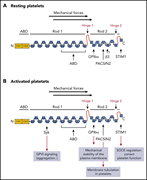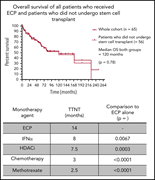Issue Archive
Table of Contents
BLOOD COMMENTARIES
An iatrogenic orphan?
Clinical Trials & Observations
ECP in the spotLIGHT
Prolonged survival with the early use of a novel extracorporeal photopheresis regimen in patients with Sézary syndrome
Gao et al report that early use of extracorporeal photopheresis improves time to next treatment and survival in patients with Sézary syndrome.
En-Abl-ing treatment of “Ph-like” ALL?
Clinical Trials & Observations
Efficacy of tyrosine kinase inhibitors in Ph-like acute lymphoblastic leukemia harboring ABL-class rearrangements
Tanasi et al present a prospective strategy for identifying patients with Philadelphia-like acute lymphoblastic leukemia, demonstrating the efficacy of early introduction of tyrosine kinase inhibitors in improving outcomes.
REVIEW ARTICLE
Filamin A: key actor in platelet biology
Filamins are scaffold proteins for signaling proteins and adhesion molecules, and mutations in filamin A (FLNa) cause a wide range of defects in the brain, cardiovascular system, gastrointestinal tract, and skeleton, as well as in megakaryocytes. Rosa and colleagues review the important role of FLNa in platelet development and its critical importance to proplatelet production by megakaryocytes.
CLINICAL TRIALS AND OBSERVATIONS
Impact of concurrent indolent lymphoma on the clinical outcome of newly diagnosed diffuse large B-cell lymphoma
CME
In this month's CME article, an analysis of over 1300 patients with diffuse large B-cell lymphoma (DLBCL), Wang et al demonstrate that the approximately 13% of patients with concurrent indolent lymphoma at diagnosis had the same prognosis as those patients with isolated DLBCL.
GENE THERAPY
Resveratrol trimer enhances gene delivery to hematopoietic stem cells by reducing antiviral restriction at endosomes
HEMATOPOIESIS AND STEM CELLS
Bone marrow CX3CR1+ mononuclear cells relay a systemic microbiota signal to control hematopoietic progenitors in mice
Lee and colleagues investigated the role of the intestinal microbiota in steady-state hematopoieisis, demonstrating that microbiota-derived DNA circulates to the bone marrow, where uptake by mononuclear cells leads to inflammatory cytokine production favoring myeloid-cell maturation of hematopoietic progenitors.
LYMPHOID NEOPLASIA
Suz12 inactivation cooperates with JAK3 mutant signaling in the development of T-cell acute lymphoblastic leukemia
Bortezomib, lenalidomide, and dexamethasone as induction therapy prior to autologous transplant in multiple myeloma
Prolonged survival with the early use of a novel extracorporeal photopheresis regimen in patients with Sézary syndrome
Gao et al report that early use of extracorporeal photopheresis improves time to next treatment and survival in patients with Sézary syndrome.
LETTERS TO BLOOD
Efficacy of tyrosine kinase inhibitors in Ph-like acute lymphoblastic leukemia harboring ABL-class rearrangements
Tanasi et al present a prospective strategy for identifying patients with Philadelphia-like acute lymphoblastic leukemia, demonstrating the efficacy of early introduction of tyrosine kinase inhibitors in improving outcomes.
BLOOD WORK
CONTINUING MEDICAL EDUCATION (CME) QUESTIONS
-
Cover Image
Cover Image
![issue cover]()
Immunofluorescence image of CX3CR1+ mononuclear cells (MNCs, green) in contact with multipotent progenitors (MPPs, purple) in the bone marrow. CX3CR1+ MNCs regulate MPPs and myelopoiesis by inflammatory cytokines induced by microbiota-derived molecules. See the article by Lee et al on page 1312.
- PDF Icon Front MatterFront Matter
- PDF Icon Table of ContentsTable of Contents
- PDF Icon Back MatterBack Matter
- PDF Icon AdvertisingAdvertising
- PDF Icon Editorial BoardEditorial Board
Advertisement intended for health care professionals
Email alerts
Advertisement intended for health care professionals










Bone marrow CX3CR1+ mononuclear cells relay a systemic microbiota signal to control hematopoietic progenitors in mice
Lee and colleagues investigated the role of the intestinal microbiota in steady-state hematopoieisis, demonstrating that microbiota-derived DNA circulates to the bone marrow, where uptake by mononuclear cells leads to inflammatory cytokine production favoring myeloid-cell maturation of hematopoietic progenitors.